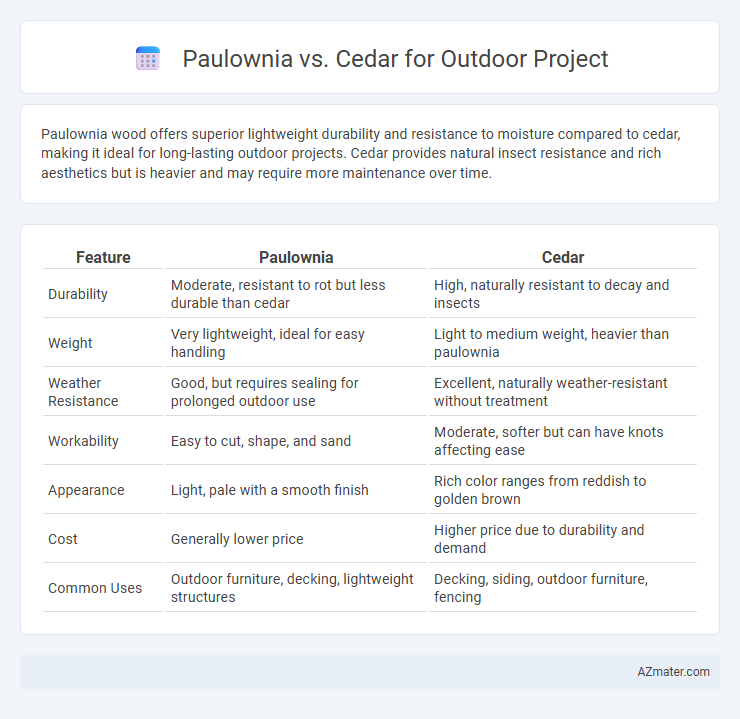Paulownia wood offers superior lightweight durability and resistance to moisture compared to cedar, making it ideal for long-lasting outdoor projects. Cedar provides natural insect resistance and rich aesthetics but is heavier and may require more maintenance over time.
Table of Comparison
| Feature | Paulownia | Cedar |
|---|---|---|
| Durability | Moderate, resistant to rot but less durable than cedar | High, naturally resistant to decay and insects |
| Weight | Very lightweight, ideal for easy handling | Light to medium weight, heavier than paulownia |
| Weather Resistance | Good, but requires sealing for prolonged outdoor use | Excellent, naturally weather-resistant without treatment |
| Workability | Easy to cut, shape, and sand | Moderate, softer but can have knots affecting ease |
| Appearance | Light, pale with a smooth finish | Rich color ranges from reddish to golden brown |
| Cost | Generally lower price | Higher price due to durability and demand |
| Common Uses | Outdoor furniture, decking, lightweight structures | Decking, siding, outdoor furniture, fencing |
Introduction to Paulownia and Cedar
Paulownia, a fast-growing hardwood, is prized for its lightweight, strength, and natural resistance to rot, making it an excellent choice for outdoor projects requiring durability and ease of handling. Cedar, known for its aromatic properties and natural oils, provides exceptional resistance to moisture, insects, and decay, ensuring long-lasting performance in exterior applications. Both woods offer unique benefits for outdoor use, with Paulownia excelling in lightweight structural elements and Cedar favored for its weather resistance and aesthetic appeal.
Wood Characteristics: Paulownia vs Cedar
Paulownia wood is lightweight, highly resistant to warping and shrinking, and has a low density that makes it easier to handle for outdoor projects. Cedar offers natural durability with excellent resistance to rot, insects, and moisture, making it a popular choice for outdoor use where longevity is crucial. Both woods feature good dimensional stability, but Paulownia's rapid growth and sustainability make it an eco-friendly alternative to the more traditionally durable cedar.
Durability and Resistance in Outdoor Conditions
Paulownia wood offers excellent durability and natural resistance to rot and insects, making it a lightweight yet resilient choice for outdoor projects. Cedar is renowned for its superior resistance to moisture, decay, and insect damage, ensuring long-lasting performance in various weather conditions. While cedar typically outperforms paulownia in terms of overall outdoor durability, paulownia's faster growth and stable dimensional properties make it a viable alternative for certain outdoor applications.
Weight and Workability Comparison
Paulownia wood is significantly lighter, weighing around 260 kg/m3, compared to cedar's density of approximately 320-400 kg/m3, which makes paulownia easier to handle for outdoor projects. Both woods offer excellent workability, but paulownia's straight grain and fine texture allow for smoother cutting and shaping with less effort. Cedar's natural oils provide resistance to decay and insects, though it requires more care during finishing due to its softer nature and tendency to splinter.
Weather Resistance and Longevity
Paulownia wood offers excellent weather resistance due to its natural oils and lightweight cellular structure, making it highly resistant to moisture, rot, and insects in outdoor projects. Cedar is renowned for its durability and natural preservatives like thujaplicins that provide exceptional resistance to decay and insect damage, ensuring long-lasting performance in varying weather conditions. Both woods require minimal maintenance, but cedar tends to have a longer lifespan in harsh outdoor environments due to its denser grain and higher resin content.
Maintenance Requirements for Each Wood
Paulownia wood requires minimal maintenance due to its natural resistance to rot and insects, making it ideal for outdoor projects with less frequent care. Cedar also offers good durability and pest resistance but benefits from regular sealing or staining to maintain its appearance and prevent weathering. Choosing between Paulownia and Cedar depends on the desired balance between low upkeep and the natural aging process of the wood in outdoor environments.
Cost Efficiency and Availability
Paulownia wood offers superior cost efficiency for outdoor projects due to its rapid growth rate and lower market price compared to cedar, making it a budget-friendly option. While cedar is widely available and renowned for its natural resistance to decay and insects, its higher cost can impact overall project expenses. Availability of paulownia may vary regionally but typically benefits from sustainable plantations, whereas cedar remains a consistently accessible choice in North America and Europe.
Eco-Friendliness and Sustainability
Paulownia wood offers superior eco-friendliness and sustainability compared to cedar due to its rapid growth rate, requiring less time to mature and reducing deforestation impact. Its ability to absorb more CO2 during growth enhances carbon sequestration, making it a greener choice for outdoor projects. Conversely, cedar, while naturally resistant to decay and pests, grows slower and demands more forest resources, impacting long-term sustainability.
Best Outdoor Applications for Paulownia and Cedar
Paulownia wood excels in outdoor applications such as decking, garden furniture, and fencing due to its lightweight, fast growth, and natural resistance to moisture and rot. Cedar is highly valued for outdoor projects like siding, shingles, and pergolas, offering excellent durability, insect resistance, and a pleasant aroma. Both woods perform well outdoors, but paulownia is ideal for lightweight structures while cedar provides a more robust and aromatic option for long-lasting exterior use.
Final Recommendations: Choosing the Right Wood
Paulownia offers exceptional lightweight durability and rapid growth, making it ideal for eco-friendly outdoor projects requiring ease of handling and resistance to moisture. Cedar provides superior natural insect resistance and a rich aromatic quality, suited for traditional outdoor structures exposed to harsh weather conditions. Select Paulownia for sustainable, lightweight applications prioritizing environmental impact, while cedar is better for long-lasting, aromatic, and naturally resilient outdoor installations.

Infographic: Paulownia vs Cedar for Outdoor Project
 azmater.com
azmater.com